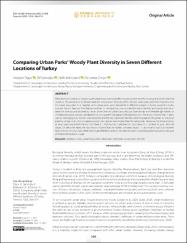| dc.contributor.author | Öğçe, Hüseyin | |
| dc.contributor.author | Şatıroğlu, Elif | |
| dc.contributor.author | Bekiryazıcı, Fatih | |
| dc.contributor.author | Dinçer, Deryanur | |
| dc.date.accessioned | 2022-11-15T05:27:12Z | |
| dc.date.available | 2022-11-15T05:27:12Z | |
| dc.date.issued | 2022 | en_US |
| dc.identifier.citation | Ogce, H., Satiroglu, E., Bekiryazici, F. & Dincer, D. (2022). Comparing Urban Parks' Woody Plant Diversity in Seven Different Locations of Turkey. Forestist, 72(3), 266-274. http://doi.org/10.54614/forestist.2022.21038 | en_US |
| dc.identifier.issn | 2602-4039 | |
| dc.identifier.uri | http://doi.org/10.54614/forestist.2022.21038 | |
| dc.identifier.uri | https://hdl.handle.net/11436/7031 | |
| dc.description.abstract | Plant diversity is critical to regulating the urban ecosystem and offers myriad positive benefits in a logical and well-planned structure. This article aims to demonstrate the woody plant diversity of the selected urban parks and their importance for the urban ecosystem. As a material, seven urban parks were selected from different locations in Turkey, located in Aydin, Istanbul, Kayseri, Samsun, Rize, Trabzon, and Van. In methodology, we recorded the plants' families and species and calculated the diversity and dissimilarity values of the selected urban parks through Shannon (alpha) and Whittaker (beta) indexes on the Paleontological Statistics and Biodiversity Component Calculation Software programs. The results showed that 71 plant species belonging to 32 families were recorded, and the most dominant families were Pinaceae and Rosaceae. As a result of planting design styles, the non-native woody plant species were higher than the native ones. Moreover, the alpha diversity of seven parks was 0.4099 (Park I), 1.931 (Park II), 1.936 (Park III), 2.564 (Park IV), 2.622 (Park V), 2.124 (Park VI), and 1.881 (VII) values. On the other hand, the beta results showed that the highest similarity value (1 - dissimilarity) was 0.28 between Parks IV and V. In conclusion, there were huge differences among the selected parks concerning plant biodiversity because of limited native plants usage. | en_US |
| dc.language.iso | eng | en_US |
| dc.publisher | İstanbul University | en_US |
| dc.rights | info:eu-repo/semantics/openAccess | en_US |
| dc.subject | Shannon | en_US |
| dc.subject | Urban ecosystem | en_US |
| dc.subject | Urban parks | en_US |
| dc.subject | Whittaker | en_US |
| dc.subject | Woody plant diversity | en_US |
| dc.title | Comparing Urban Parks' woody plant diversity in seven different locations of Turkey | en_US |
| dc.type | article | en_US |
| dc.contributor.department | RTEÜ, Mühendislik ve Mimarlık Fakültesi, Peyzaj Mimarlığı Bölümü | en_US |
| dc.contributor.institutionauthor | Şatıroğlu, Elif | |
| dc.contributor.institutionauthor | Bekiryazıcı, Fatih | |
| dc.contributor.institutionauthor | Dinçer, Deryanur | |
| dc.identifier.doi | 10.54614/forestist.2022.21038 | en_US |
| dc.identifier.volume | 72 | en_US |
| dc.identifier.issue | 3 | en_US |
| dc.identifier.startpage | 266 | en_US |
| dc.identifier.endpage | 274 | en_US |
| dc.relation.journal | Forestist | en_US |
| dc.relation.publicationcategory | Makale - Uluslararası Hakemli Dergi - Kurum Öğretim Elemanı | en_US |


















